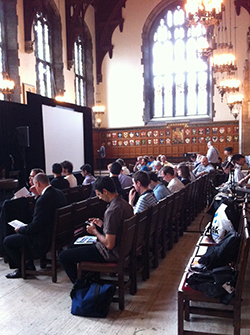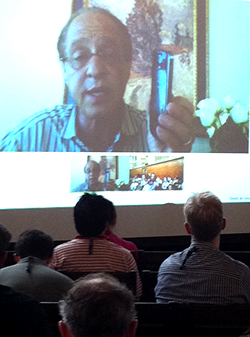June 27, 2013

Future-minded thinkers from around the globe descended on the University of Toronto this week as the International Symposium on Technology & Society, or ISTAS 2013, launched its three-day program on the theme Smart World: People as Sensors.
Attendees received a warm welcome from Laura Jacob, president of the IEEE’s Society on Social Implications of Technology, and Professor Farid Najm, chair of the Edward S. Rogers Sr. Department of Electrical & Computer Engineering. Conference Organizing Chair Ryan Janzen, an ECE PhD student in Professor Steve Mann‘s EyeTap Laboratory, officially opened the event.
Mann, often called ‘the father of wearable computing,’ delivered the day’s first keynote on the opposing concepts of surveillance (to watch from above) and sousveillance (to watch from below).
“Surveillance and sousveillance is kind of 21st century, us vs. them,” said Mann. “Sousveillance is the veillance of integrity, of honesty.”
Mann proposed extracting the value-neutral term, veillance, to describe our new watchful society—a world in which everything, and everyone, is equipped with cameras and monitoring devices.
Ray Kurzweil, renowned futurist, author, inventor and now director of engineering at Google, delivered his keynote in a Google+ ‘hangout’ session from his office in California. Kurzweil spoke of a disconnect between how the human mind conceives of progress, and the pace at which society is actually progressing.

“Our intuition about the future is linear, not exponential,” said Kurzweil. We predict the future in direct proportion to the past, and “anticipate things will change at a constant pace.” Not so, he said—our technological capability is growing exponentially, even as its cost decreases exponentially.
“Ultimately [computers] will go inside our brains and become gateways for our neocortical structures into the cloud,” he said. “We will create a brain to overcome the greatest challenges of humanity.”
The ‘father of artificial intelligence,’ Marvin Minsky, delivered the morning’s final keynote. “2001 is past, but where is Hal?” he asked in his presentation. “Soon we’ll need machines that use more commonsense knowledge and reasoning.”
Minsky argued that soon machines will know the millions of tiny facts adult brains accumulate to let them navigate the world. “When we reach the singularity, where do we go from there?” he asked, referring to the predicted point at which machine learning will overtake human capability. “Once someone knows a lot, what’s the point of having more than one of that person or thing?” said Minsky. “What’s the future of the future, you’re asking? I have no idea.”
The future of the future is exactly what the diverse group in the room had come to discuss. ISTAS’13 continues Friday and Saturday; read more on the conference website: http://veillance.me/
Media contact:
Marit Mitchell
Senior Communications Officer
The Edward S. Rogers Sr. Department of
Electrical & Computer Engineering
416-978-7997; marit.mitchell@utoronto.ca